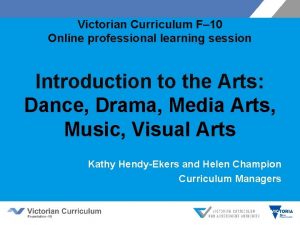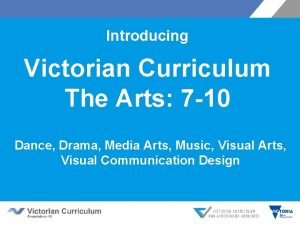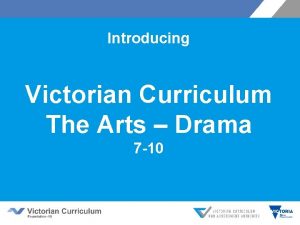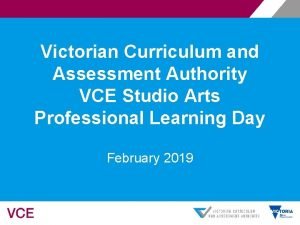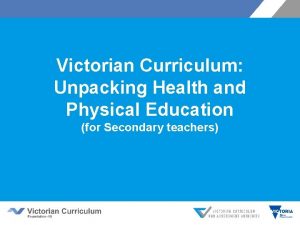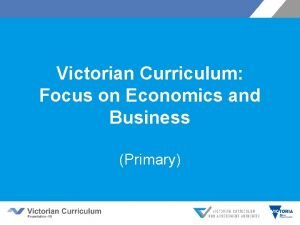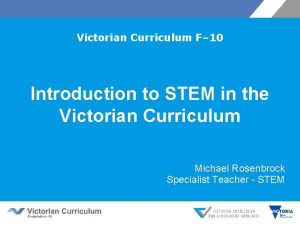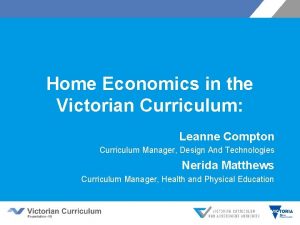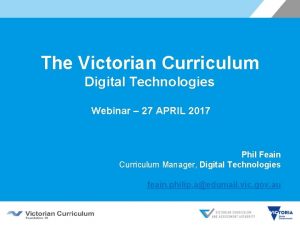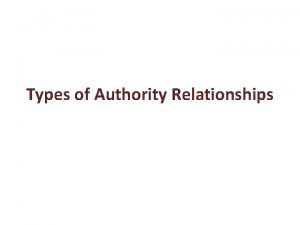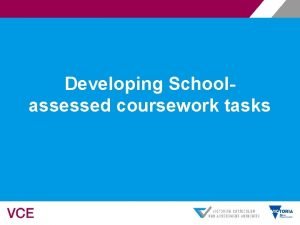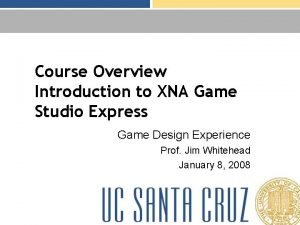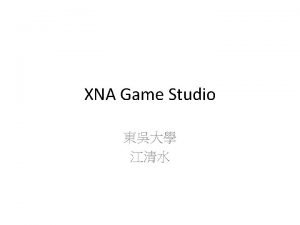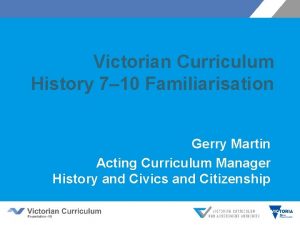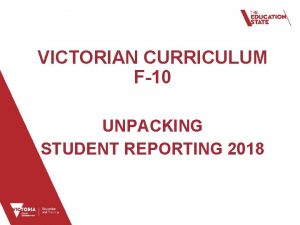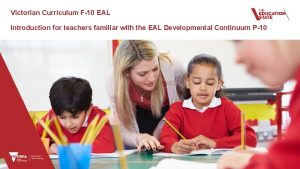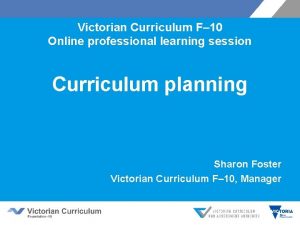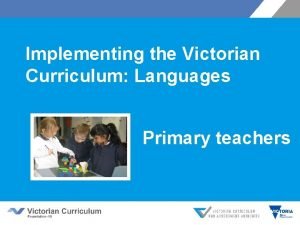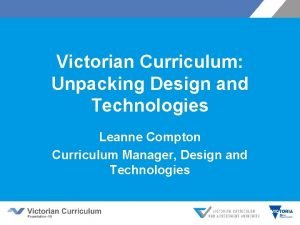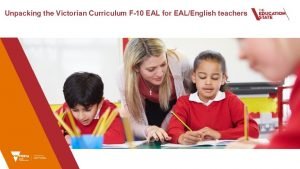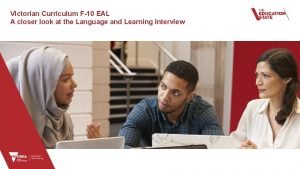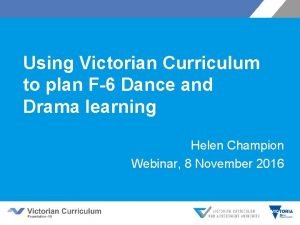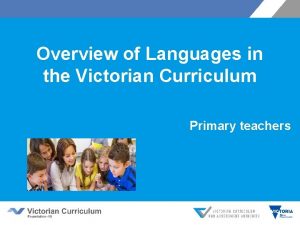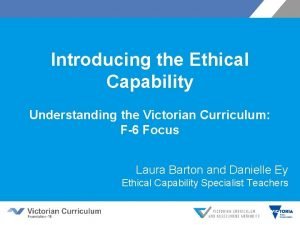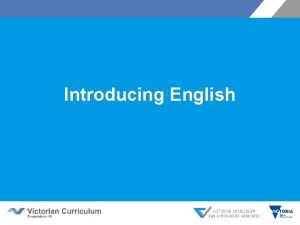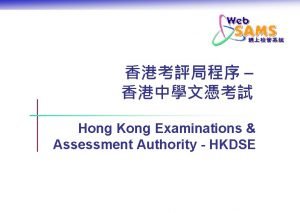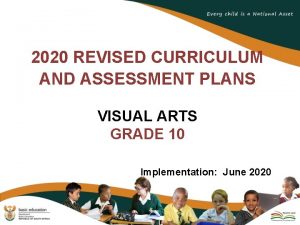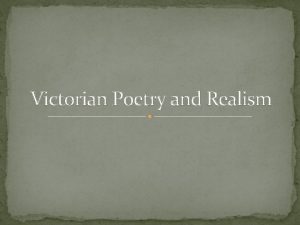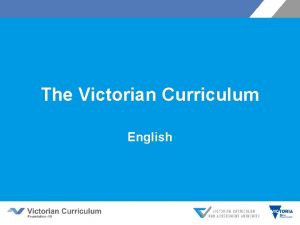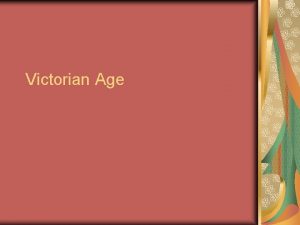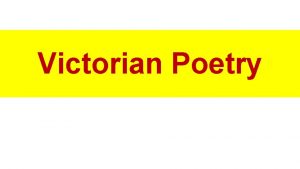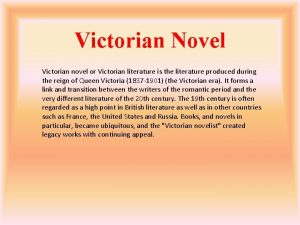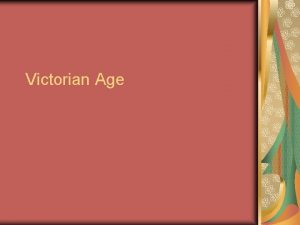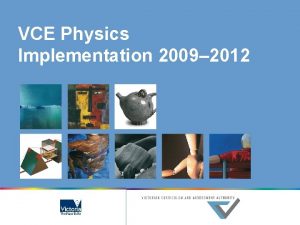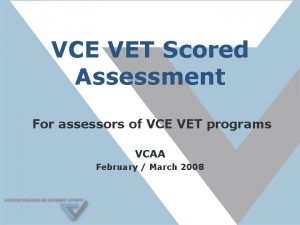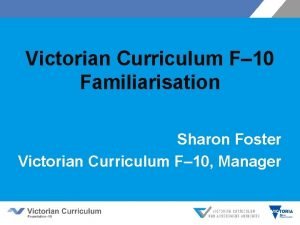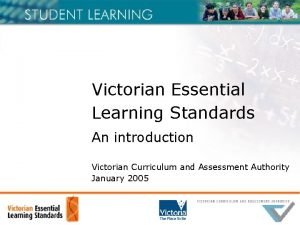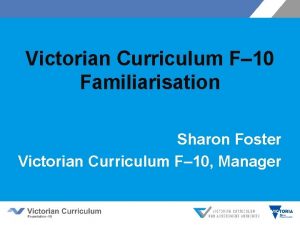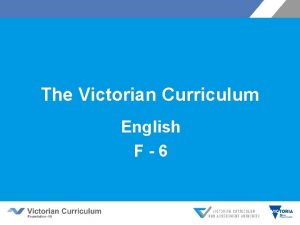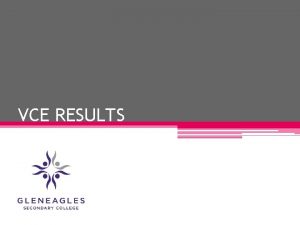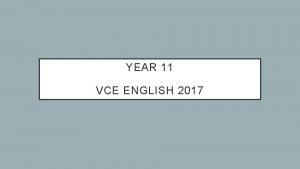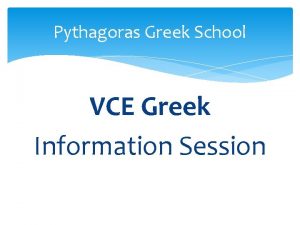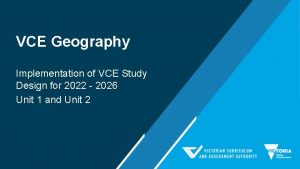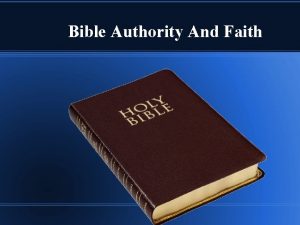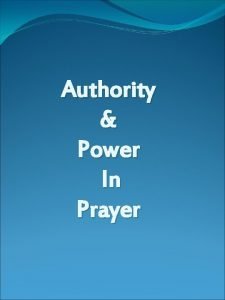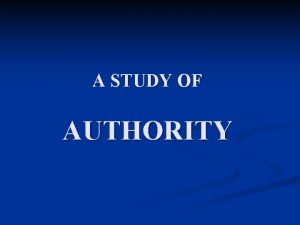Victorian Curriculum and Assessment Authority VCE Studio Arts


















































- Slides: 50

Victorian Curriculum and Assessment Authority VCE Studio Arts Professional Learning Day February 2019

Contact Any questions or concerns regarding Studio Arts curriculum should be directed to: Kathryn Hendy-Ekers | Curriculum Manager, Visual Arts & Media Victorian Curriculum & Assessment Authority Level 32, 2 Lonsdale Street, Melbourne VIC 3000 T: (03) 9032 1697 | M: 0438 471 513 E: Hendy-Ekers. Kathryn. l@edumail. vic. gov. au

Where to find documents

Studio Arts Study Design Page Study Design Admin advice SAT. Updated each year Assessment criteria & Admin for SAT. Updated each year Exam advice Past exams, specifications and sample exams Introductory Power. Point and Frequently Asked Questions http: //www. vcaa. vic. edu. au/Pages/vce/studies/studio arts/studioindex. aspx

Bulletin & Notices to Schools Check regularly Subscribe to the bulletin http: //www. vcaa. vic. edu. au/Pages/correspondence/index. aspx#bulletin

Administration Dates & Assessment Schedule http: //www. vcaa. vic. edu. au/pages /schooladmin/admindates/index. as px

Administration Handbook http: //www. vcaa. vic. edu. au/Pages/schooladmin/handbook/2017 /index. aspx

Studio Arts Assessment Entry into VASS Assessment Date School-assessed Task Criteria 1 - 5 Friday 14 June, 2019 • School-assessed Coursework scores Unit 3 • S and N scores Unit 3 Monday 09 September, 2019 School-assessed Task Criteria 6 - 10 Wednesday 06 November, 2019 • School-assessed Coursework scores Unit 4 • S and N scores Unit 4 Wednesday 06 November, 2019 Return of School-assessed Tasks Friday 08 November, 2019

Moderation The VCAA will be running Moderation sessions for the School-assessed Task in the following weeks. • Unit 3: Week commencing 13 May, 2019 • Unit 4: Week commencing 19 August, 2019 These sessions will be held at Coburg and Bendigo.

School-based Assessment Audit • All VCE providers are audited for at least one VCE study each year. • All VCE studies are subject to the audit – includes both SACs and SATs. • Checks that school-based assessment is conducted in line with VCAA principles of assessment and the requirements of the relevant study design, using appropriately designed tasks.

School-based Assessment Audit 2019 • In 2019 a sample of five schools from VCE Art will be selected to upload student work for audit for Stage 2 and 4 of the audit. • Stage 2: 27 May, 2019 • Stage 4: 20 September, 2019

Authentication – School-assessed Task • • Teachers must comply with Authentication requirements. These documents are used to provide evidence of student progression and as a platform to deliver feedback. Teachers are reminded that the authentication procedures are required to be followed for all student work in relation to this SAT. School-based Assessment Audits include the inspection of authentication records. Where authentication records are not provided, the school is automatically audited the following year. Authentication records and Additional comment sheets will also be required to be forwarded for all works nominated for the Season of Excellence in 2019. Incomplete authentication records will result in an automatic disqualification of the student work from the nomination process.

Authentication Record Form

Additional Comments Criterion 1: Preparation of an exploration proposal and work plan that formulates the content and parameters of an individual studio process. • Is the exploration proposal within the word limit? • Is there a weekly work plan that outlines the structure of the studio process? • Is visual information presented in the exploration proposal appropriately acknowledged? Criterion 2: Interpretation of and response to sources of inspiration to explore, develop and refine ideas throughout the studio process. • Have a range of sources of artistic and personal inspiration used to explore ideas in the studio process? • Have the sources of inspiration been appropriately acknowledged in the studio process? Criterion 3: Exploration of conceptual possibilities in the studio process that develops individual and personal subject matter as discussed in the exploration proposal and work plan. • Is there a consistent theme in the studio process? • Does the studio process address a range of related ideas to address a theme? • Is there a clear use of personal subject matter in the studio process? • Is there a relationship between the subject matter identified in the exploration proposal and ideas explored in the studio process? Criterion 4: Apply skills to explore art elements and principles, materials, techniques and processes that communicate individual ideas and demonstrate aesthetic qualities. • Have the ideas presented in the exploration proposal been examined through a range of trials and experiments? • Have materials and techniques relevant to the art form/s discussed in the exploration proposal been explored through a range of trials and experiments? • Has the work plan been annotated to reflect the progress of the studio process? Criterion 5: Documentation of exploratory and developmental work in the studio process clarifies ideas to identify and evaluate potential directions. • Is the exploratory and developmental work presented and organised in a visual diary? • Do written annotations and visual material clarify the ideas presented in the visual diary? • Have a range of potential been identified and evaluated in the visual diary?

Criterion 6: Use of selected and evaluated potential directions in the resolution of future artworks. • Have at least two potential directions or parts of potential directions been identified to resolve the development of at least two finished artworks? • Have any improvements to the potential directions been documented? • Has a written outline about the resolution of two artworks been presented to clarify the use of selected potential directions? Criterion 7: Application of materials, techniques and processes appropriate to the selected art forms that and their inherent characteristics in the resolution of at least two finished artworks. • How has the student used materials, techniques and processes of a selected art form? • How has the use of materials, techniques and processes advanced on the potential directions? • How has the student used the characteristics of the materials, techniques and processes of the art form? Criterion 8: Demonstration and resolution of aesthetic qualities in relation to the communication and realisation of ideas in at least two finished artworks. • What are the aesthetic qualities used by the student that communicate ideas expressed in the exploration proposal? • What is the subject matter depicted and how does it communicate and realise ideas in two finished artworks? Criterion 9: Demonstration of the cohesive relationship between at least two finished artworks. • How are the finished artworks cohesive? • What are the links between the artworks? • What are the relationships between the artworks? Criterion 10: Written documentation that evaluates and reflects on the studio process. • Is the evaluation within the word limit? • Is the presentation of the artworks addressed through photographs, diagrams, illustrations or mock-ups? • Have the artworks been clearly labelled on the evaluation document alongside the potential directions employed to resolve the artworks?

Additional Comment Sheet

Criteria 1 • Unit 3 • Outcome 1 • Preparation of an exploration proposal and work plan that formulates the content and parameters of an individual studio process.

Criteria 1: Evidence • • • EXPLORE The exploration proposal is in the range of 750 - 1000 words. Visual material is cited and referenced to support the ideas, subject matter and conceptual possibilities explained in the exploration proposal. The exploration proposal must address the following content: the focus and subject matter to be developed the ideas to be explored the art forms that will be explored through the studio process the analysis and interpretation of sources of inspiration relevant to student ideas conceptual possibilities the use of art elements, art principles and aesthetic qualities to be investigated the materials and techniques to be explored and developed plan of the studio process. At the end of the exploration proposal there is a work plan that provides a weekly overview to explain how the studio process will be structured and managed.


Criteria 2 • Unit 3 • Outcome 2 • Interpretation of and response to sources of inspiration to explore, develop and refine ideas throughout the studio process

Criteria 2: Evidence • EXPLORE – DEVELOP – REFINE • There are written and visual references in the form of annotations and citations that explain how artistic and personal influences will be used and interpreted throughout the studio process.


Criteria 3 • Unit 3 • Outcome 2 • Exploration of conceptual possibilities in the studio process that develops individual and personal subject matter as discussed in the exploration proposal and work plan.

Criteria 3: Evidence • EXPLORE – DEVELOP – REFINE • Exploration of conceptual possibilities is linked to the selection and development of individual and personal subject matter discussed in the exploration proposal and work plan. • In response to conceptual possibilities, a range of personal and individual subject matter is progressively explored, developed and refined through documentation in the studio process.




Criteria 4 • Unit 3 • Outcome 2 • Apply skills to explore art elements, art principles, materials, techniques and processes that communicate individual ideas and demonstrate aesthetic qualities.

Criteria 4: Evidence • EXPLORE – DEVELOP – REFINE • use of materials, techniques and processes relevant to the art form/s discussed in the exploration proposal • use of art elements and principles to demonstrate aesthetic qualities • application and refinement of skills in the use of materials, techniques and processes relevant to the art form/s discussed in the exploration proposal • use of materials, techniques and processes to demonstrate aesthetic qualities and develop visual language.


Criteria 5 • Unit 3 • Outcome 2 • Documentation of exploratory and developmental work in the studio process clarifies ideas to identify and evaluate potential directions.

Criteria 5: Evidence • EXPLORE – DEVELOP – REFINE • Written and visual documentation in a visual diary that includes research, trials and experiments relating to the ideas expressed in the exploration proposal and work plan • Methods for progressively recording and documenting visual and written explorations in a visual diary. (For example: The visual diary is paginated and most pages are dated). • Strategies for identifying, developing and evaluating a range of potential directions: (For example: A range of potential directions are clearly numbered and titled At least two potential directions have been identified and evaluated using art terminology. There is associated exploration and developmental work with each potential direction.




Criteria 6 • Unit 4 • Outcome 1 • Use of selected and evaluated potential directions in the resolution of future artworks.

Criteria 6: Evidence • RESOLVE • A brief written outline should be presented at the start of Unit 4 to explain the use of selected potential directions and how they will be used to resolve two artworks (This is not included in the word count for the evaluation for Unit 4, Outcome 2) • At least two potential directions are used as the basis for the resolution of at least two finished artworks that link to the exploration proposal. • Documented planning for the resolution of finished artworks is presented for authentication purposes.


Criteria 7 • Unit 4 • Outcome 1 • Application of materials, techniques and processes appropriate to the selected art forms that utilise their inherent characteristics in the resolution of at least two finished artworks.

Criteria 7: Evidence • RESOLVE • Application of materials and techniques in the resolution of at least two finished artworks based upon selected and evaluated potential directions. • Appropriate use of the inherent characteristic of materials relevant to the art form identified in the exploration proposal.


Criteria 8 • Unit 4 • Outcome 1 • Demonstration and resolution of aesthetic qualities in relation to the communication and realisation of ideas in at least two finished artworks.

Criteria 8: Evidence • RESOLVE • Resolution of aesthetic qualities and personal subject matter to communicate individual ideas in at least two finished artworks through the consistent and considered application of art elements and art principles.


Criteria 9 • Unit 4 • Outcome 1 • Demonstration of the cohesive relationship between at least two finished artworks.

Criteria 9: Evidence • PRESENT • The presentation of at least two artworks is cohesive and linked by themes and ideas. • As referenced in the exploration proposal and work plan, cohesive relationships in the two artworks may be established through the depiction of subject matter and/or aesthetic qualities and/or application of materials, techniques and processes.


Criteria 10 • Unit 4 • Outcome 2 • Written documentation that evaluates and reflects on the studio process.

Criteria 10: Evidence • • • PRESENT The evaluation is in the range of 750 - 1000 words. The document includes visual references to the potential directions that form the basis of the two finished artworks. The evaluation document must include the following: Description of focus subject matter and ideas in at least two finished artworks. Visual evidence of selected potential directions in at least two finished artworks. Evaluation of the contribution of potential directions to the resolution of artworks. Analysis of the realisation and communication of ideas in at least two finished artworks Evaluation of the resolution of materials, techniques and aesthetic qualities used to communicate ideas. Evaluation of the cohesive relationships between artworks. Evaluation of the presentation of at least two artworks. The presentation of at least two finished artworks may include a discussion of the space in which the artworks will be displayed, lighting, wall colour and arrangement or sequence of the artworks in the space through illustrations, diagrams, images or photographs.

 Victorian curriculum visual arts scope and sequence
Victorian curriculum visual arts scope and sequence Victorian curriculum arts
Victorian curriculum arts Victorian curriculum art
Victorian curriculum art Victorian curriculum drama
Victorian curriculum drama Studio arts assessment criteria 2021
Studio arts assessment criteria 2021 Grand era floral design
Grand era floral design Geometric mass design
Geometric mass design Creative arts grade 7 lesson plans term 3
Creative arts grade 7 lesson plans term 3 Health and physical education victorian curriculum
Health and physical education victorian curriculum Victorian curriculum health and physical education
Victorian curriculum health and physical education Victorian curriculum economics and business
Victorian curriculum economics and business Critical and creative thinking vic curriculum
Critical and creative thinking vic curriculum Victorian curriculum history scope and sequence
Victorian curriculum history scope and sequence Victorian curriculum science scope and sequence
Victorian curriculum science scope and sequence Victorian curriculum economics and business
Victorian curriculum economics and business Victorian curriculum digital technologies
Victorian curriculum digital technologies What is line authority?
What is line authority? Vce assessment principles
Vce assessment principles Xna visual studio 2017
Xna visual studio 2017 Xna game studio visual studio 2017
Xna game studio visual studio 2017 Victorian curriculum history
Victorian curriculum history Vchpeh
Vchpeh Victorian eal curriculum
Victorian eal curriculum Vic curriculum progression points
Vic curriculum progression points Music curriculum victoria
Music curriculum victoria Victorian curriculum economics
Victorian curriculum economics Different types of dinosaurs
Different types of dinosaurs Victorian curriculum japanese
Victorian curriculum japanese Victorian curriculum technology
Victorian curriculum technology Victorian curriculum eal
Victorian curriculum eal Intercultural capability vic curriculum
Intercultural capability vic curriculum Eal victorian curriculum
Eal victorian curriculum Victorian curriculum dance
Victorian curriculum dance Googliser
Googliser Victorian curriculum ethical capabilities
Victorian curriculum ethical capabilities Victorian curriculum eal
Victorian curriculum eal Cdr websams
Cdr websams Curriculum assessment and reporting framework
Curriculum assessment and reporting framework 2020 revised curriculum and assessment plans
2020 revised curriculum and assessment plans 2020 revised curriculum and assessment plans
2020 revised curriculum and assessment plans 2021 revised curriculum and assessment plans
2021 revised curriculum and assessment plans 2020 revised curriculum and assessment plans
2020 revised curriculum and assessment plans Conclusion of life skills
Conclusion of life skills 2021 revised curriculum and assessment plans
2021 revised curriculum and assessment plans Physical features of south africa grade 5
Physical features of south africa grade 5 2020 revised curriculum and assessment plans
2020 revised curriculum and assessment plans 2020 revised curriculum and assessment plans
2020 revised curriculum and assessment plans Qsa assessment bank
Qsa assessment bank 2020 revised curriculum and assessment plans
2020 revised curriculum and assessment plans Revised curriculum 2020
Revised curriculum 2020 2020 revised curriculum and assessment plans
2020 revised curriculum and assessment plans
